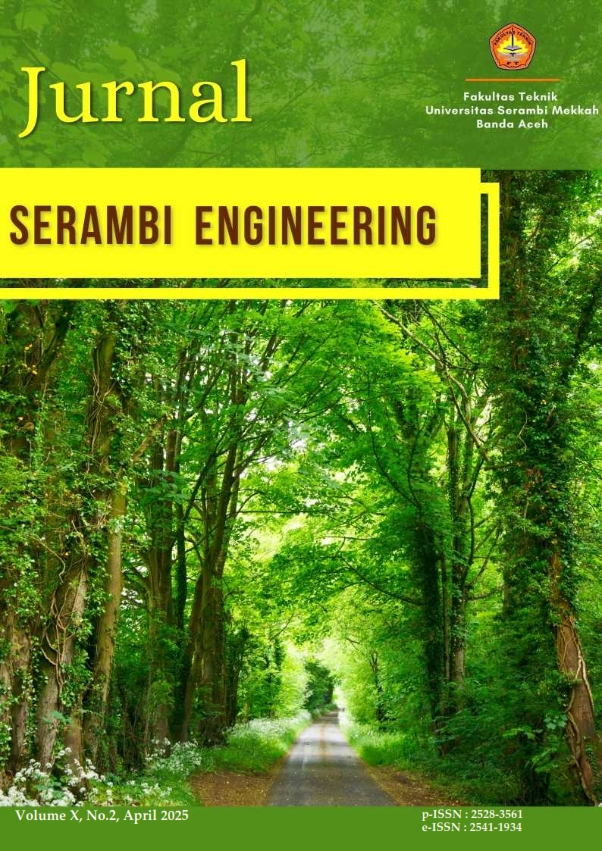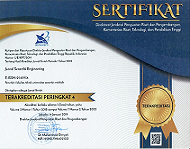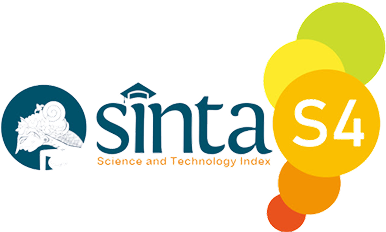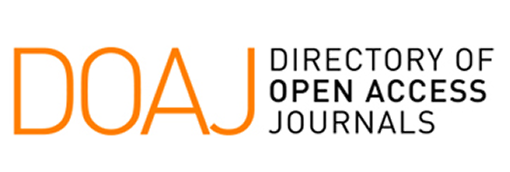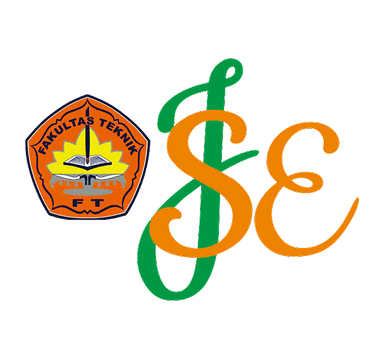Pengembangan Sistem dan Model Bisnis Pengelolaan Lumpur Tinja di Kota Sawahlunto
Keywords:
fecal sludge management system, swot analysis, business model, sawahlunto cityAbstract
Domestic wastewater management in Sawahlunto City is done by local system. About 75.5% of the houses use septic tanks, 4.1% are discharged into drainage channels, 4.5% are discharged into rivers, 15.9% have unknown location of domestic waste disposal. This study used primary data obtained from distribution of questionnaires to 100 respondents, interviews with stakeholders and field observations. Secondary data was obtained from related agencies. Evaluation of existing conditions through 5 aspects and determination of development strategy through SWOT analysis (Strengths, Weaknesses, Opportunities, Threats) and business model selection using business model canvas. The result was an average desludging production rate of 0.4 liters/person/day. About 64% of the respondents stated that they have never emptied their septic tanks and 56% of the respondents did not know about Integrated Pond Treatment (IPLT). The SWOT analysis shows that the project is in quadrant II, which means that the development strategy includes drafting regulations on domestic wastewater management, transferring the authority of desludging management to the PUPR office, continuous dissemination of information, and collaboration with the private sector in the dissemination of CSR (Corporate Social Responsibility). Based on the assessment of the business model canvas, the business model for the short term is co-composting and the business model for the long term is scheduled desludging management. Another alternative is to use fecal sludge as briquettes that can be used as a substitute fuel for coal in Sawahlunto City.
References
Abfertiawan, M. S. (2019). Studi Kondisi Eksisting Sistem Pengelolaan Air Limbah Domestik Setempat di Kota Denpasar. Jurnal Ilmu Lingkungan, 17(3), 443. https://doi.org/10.14710/jil.17.3.443-451
Bao, P. N., Abfertiawan, M. S., Kumar, P., & Hakim, M. F. (2020). Challenges and opportunities for septage management in the urban areas of Indonesia – Case study in Bandung City. Journal of Engineering and Technological Sciences, 52(4), 481–500. https://doi.org/10.5614/j.eng.technol.sci.2020.52.4.3
Badan Pusat Statistik Kota Sawahlunto (2021) Kota Sawahlunto dalam Angka 2021. Sawahlunto. Badan Pusat Statistik Sawahlunto.
Badan Perencanaan Pembangunan Daerah Kota Sawahlunto. (2019). Dokumen Review Strategi Sanitasi Kota Sawahlunto. Bappeda
Badan Perencanaan , penelitian dan pembangunan daerahKota Sawahlunto (2019). Dokumen Review Buku Putih Sanitasi Kota Sawahlunto. Barenlitbangda
Badan Perencanaan Pembangunan Daerah Kota Sawahlunto. (2016). Dokumen Review Master Plan Air Limbah Kota Sawahlunto. Bappeda
Cheng, S. K., Zheng, L., Zhao, M. Y., Bai, X., Li, Z. F., & Mang, H. P. (2017). Assessment of two faecal sludge treatment plants in urban areas: Case study in Beijing. International Journal of Agricultural and Biological Engineering, 10(3), 237–245. https://doi.org/10.3965/j.ijabe.20171003.3067
CV.Jasa Panggaso Consultant. (2020). Laporan Akhir DED IPLT Kota Sawahlunto
Dinas PUPR Kabupaten Bangka.(2020). SOP Insatalasi Pengolahan Lumpur Tinja Kabupaten Bangka
Darojat, Zakiyah, (2018). Evaluasi pelayanan IPLT Kota Sawahlunto. Institut Teknologi Sepuluh Nopember.
Dodane, P. H., Mbéguéré, M., Sow, O., & Strande, L. (2012). Capital and operating costs of full-scale fecal sludge management and wastewater treatment systems in Dakar, Senegal. Environmental Science and Technology, 46(7), 3705–3711. https://doi.org/10.1021/es2045234
Heniegal, A. M., Ramadan, M. A., Naguib, A., & Agwa, I. S. (2020). Study on properties of clay brick incorporating sludge of water treatment plant and agriculture waste. Case Studies in Construction Materials, 13, e00397. https://doi.org/10.1016/j.cscm.2020.e00397
Hidayat, H., Sasmita, A., & Reza, M. (2017). Perencanaan pembangunan instalasi pengolahan lumpur tinja (IPLT) di Kecamatan Tampan Kota Pekanbaru (Doctoral dissertation, Riau University)
IUWASH Plus. (2016). Saatnya Sekarang ! - Layanan Lumpur Tinja Terjadwal. 168.
Kementerian PUPR. (2017). Pedoman Perencanaan Teknik Terinci Instalasi Pengolahan Lumpur Tinja (IPLT).
Lumunon, Elvano. I. (2021) Evaluasi Kinerja Instalasi Pengolahan Air Limbah Komunal Kiniar di Kota Tondano. Universitas Sam Ratulangi
Maulidi, A. (2016). Pengertian Data Primer Dan Data Sekunder. Kanal Informasi. http://webcache.googleusercontent.com.
Peal, A., Evans, B., Blackett, I., Hawkins, P., & Heymans, C. (2014). Fecal sludge management: A comparative analysis of 12 cities. Journal of Water Sanitation and Hygiene for Development, 4(4), 563–575. https://doi.org/10.2166/washdev.2014.026
Permen PUPR No.04. (2017). Peraturan Menteri Pekerjaan Umum dan Perumahan Rakyat Nomor 04/PRT/M/2017 tentang Penyelenggaraan Sistem Pengelolaan Air Limbah Domestik.
Peraturan Presiden Republik Indonesia Nomor 2020 tentang Rencana Pembangunan Jangka Menengah Nasional 2020 – 2024
Peraturan Kota Sawahlunto, (2016). Peraturan Daerah Kota Sawahlunto Nomor 14 Tahun 2016 tentang pembentukan dan susunan Perangkat Daerah. Pemerintah Kota Sawahlunto: Sawahlunto
Peraturan Kota Sawahlunto, (2011). Peraturan Daerah Kota Sawahlunto Nomor 11 Tahun 2011 tentang retribusi Jasa Umum. Pemerintah Kota Sawahlunto: Sawahlunto
Pratiwi, Yeni (2019). Analisis Kebutuhan Instalasi Pengolahan Lumpur Tinja (IPLT) di Kabupaten Sawahlunto. Institut Teknologi Sepuluh Nopember
Purba, R., Kasman, M., & Herawati, P. (2020). Evaluasi dan Optimalisasi Instalasi Pengolahan Lumpur Tinja (IPLT) Talang Bakung Jambi. Jurnal Daur Lingkungan, 3(1), 33. https://doi.org/10.33087/daurling.v3i1.41
Rangkuti, F. (2016). Teknik membedah kasus bisnis Analisis SWOT. PT. Gramedia Pustaka Utama: Jakarta
Rao, K. C., Velidandla, S., Scott, C. L., & Drechsel, P. (2020). Business models for fecal sludge management in india. In Resource Recovery and Reuse (Vol. 2020, Issue 18 Special Issue). https://doi.org/10.5337/2020.209
Satrina, Steffie (2016), Evaluasi Kinerja Instalasi Lumpur Tinja (IPLT) Supiturang Kota Malang [Thesis]. Malang. Universitas Brawijaya
Sanka, Paulo Martin et al(2023). Production of Low Emission Briquettes from Faecal Sludge as an Alternative Source of Cooking Energy. Research Square. https://doi.org/10.21203/rs.3.rs-2821848/v1
Simiyu, S., Chumo, I., & Mberu, B. (2021). Fecal Sludge Management in Low Income Settlements: Case Study of Nakuru, Kenya. Frontiers in Public Health, 9(October), 1–8. https://doi.org/10.3389/fpubh.2021.750309
Sugiyono, (2012). Metode Penelitian Kuantitatif, Kualitatif dan R&D. CV. Alfabeta: Bandung
SNI.(2002). SNI 03-2398:2002 tentang Tata Cara Perencanaan Tangki Septik dengan Sistem Resapan.
SNI.(2002). SNI 03-2399:2002 tentang Tata Cara Perencanaan Bangunan MCK Umum.
SNI.(2017). SNI 2398:2017 tentang Tata Cara Perencanaan Tangki Septik dengan Pengolahan Lanjutan (Sumur Resapan, Bidang Resapan, Up flow Filter, Kolam Sanita). Jakarta,31.
Strande, Linda et al. (2018). Methods to reliably estimate faecal sludge quantities and qualities for the design of treatment technologies and management solutions. Journal of Environmental Management, 223(June), 898–907. https://doi.org/10.1016/j.jenvman.2018.06.100
Taweesan, Achara et al. (2015). Effective faecal sludge management measures for on-site sanitation systems. Journal of Water Sanitation and Hygiene for Development, 5(3), 483–492. https://doi.org/10.2166/washdev.2015.010
Thcobanoglous, G., Burton, F. L., & Stensel, H. D. (2003). Waste Water Engineering Treatment & Reuse. Republic Of China. Mcgraww Hill Companies Inc
USAID. (2016). Panduan keuangan layanan lumpur tinja terjadwal. 38. www.iuwash.or.id
Wati, S. M. (2021). Optimalisasi Layanan Lumpur Tinja Terjadwal (LLTT) IPLT Supit Urang Kota Malang
World Bank (2016) Indonesia's Urban Story. World Bank. Available on: http://www.worldbank.org/en/news/feature/201 6/06/14/indonesia-urban-story
World Bank (2017). Meeting Indonesia’s Urban Sanitation Needs. Published by The World Bank. Available on: http://www.worldbank.org/en/news/feature/201 7/03/21/meeting-indonesia-urban-sanitationneeds
Downloads
Published
Issue
Section
License
Copyright (c) 2025 Heantomas, Puti Sri Komala, Slamet Raharjo (Author)

This work is licensed under a Creative Commons Attribution 4.0 International License.

